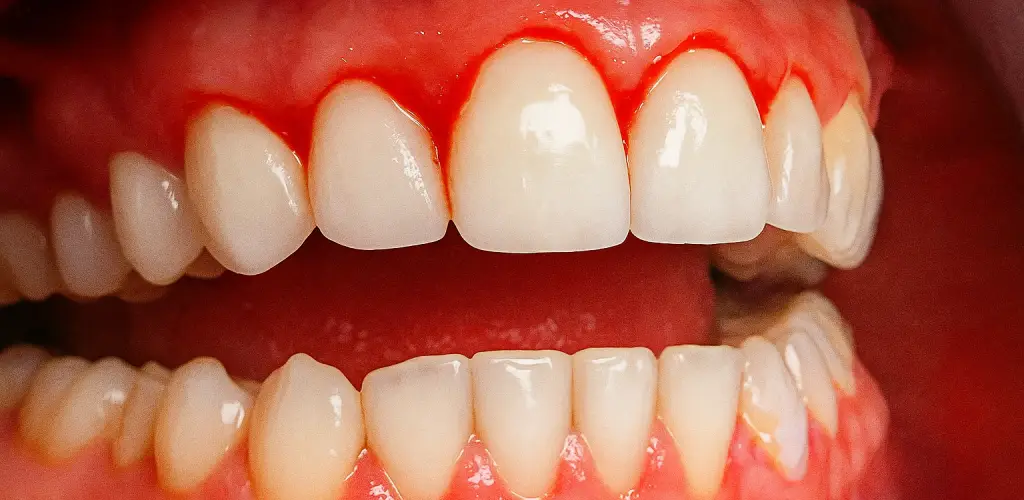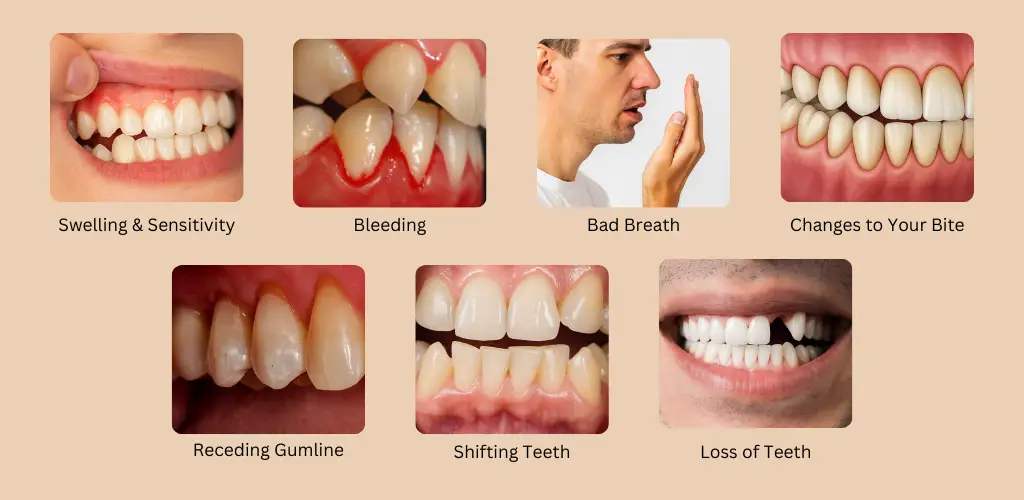Gum Disease Warning Signs | Treatment & Causes
You’re probably not the only one to have witnessed a bit of blood in the sink when brushing. But it’s how you react to it that will make a difference!
Bleeding gums are the most common warning sign of gum disease that many fail to catch in time. Gum infection in its mildest form is visible through bleeding, swelling, and redness.
At 65 Broadway Dental, we know how simple gum swelling or bleeding can progress into an issue that requires periodontics. The results when untreated could be loss of teeth, affecting your ability to eat, speak, and smile.
This article aims to help you identify gum disease warnings and understand your treatment options.
What is Gum Disease?
Gum disease is described as a chronic bacterial infection in the gums. These infections arise when a sticky bacterial film called plaque hardens into tartar. Tartar above and below the gumline can lead to advanced gum infections.

Gum disease is a condition that affects a large number of people. It has four stages: gingivitis, Mild periodontitis, moderate periodontitis, and advanced periodontitis.
According to a study on periodontitis in The Journal of the American Dental Association, almost half (42%) of adults over 30 years of age in the USA have some form of gum disease.
It shows the widespread occurrence of this condition in the USA, but global stats from the World Health Organization (WHO) place it at over 1 billion global severe periodontitis cases.
These statistics highlight how easy it is for this condition to spread undetected. It also speaks volumes about the availability of dental services to people worldwide.
What Are the 7 Warning Signs of Gum Disease?
These 7 warning signs should be taken seriously, as they could be signs of gum disease. We’ve arranged them in order of severity, from least severe to most severe.

1. Swelling & Sensitivity
Healthy gums are firm and pink in color. The appearance of red and puffy, almost bouncy gums is worrying. This sign of inflammation signals that the gums are in poor health. Most dentists warn that this is the first sign of potential gum issues.
Another symptom that adds to this is sensitivity that displays as tooth and gum pain while eating. This tenderness appears while consuming hot or cold foods and drinks.
“Many patients think gum sensitivity is just part of brushing or flossing, when actually, gum sensitivity happens because infection weakens the tissue that normally protects your teeth”
— Dr. Alexander Heifitz
2. Bleeding
Regular bleeding during or after brushing or flossing is not normal! Using an incorrect toothbrush or brushing method can sometimes cause bleeding. But when it happens frequently, there’s an underlying reason that needs attention, you can explore more about the common causes of bleeding gums to identify what might be affecting you.
Bleeding while flossing with soft waxed floss is also an alarming sign. People who experience it shouldn’t ignore it, and definitely not for long!
3. Bad Breath
People naturally think that unbrushed teeth cause bad breath. This isn’t always true, as bacteria below the gumline can contribute to poor breath. Chronic halitosis, or persistent bad breath, can result from diseased gums.
You should suspect your gums if brushing and using mouthwash still can’t improve your breath. Addressing this issue promptly can prevent it from impacting your social life.
4. Changes to Your Bite
Have you closed your mouth recently and found that your teeth don’t align properly? Periodontitis can do that, too!
Since jawbones are partly responsible for alignment, gum-damaging bacteria can affect these structures. This creates movement of the supportive jawbone and the teeth.
A bite can change over the course of time, which is why many people don’t notice. Unfortunately, by the time it becomes a problem, the effects are severe.
5. Receding Gumline
A common warning sign of gum disease is receding gums. This condition is identified by your teeth appearing longer or your gums appearing smaller.
It occurs due to the gums shrinking. It’s dangerous because it creates pockets between gums and teeth. These empty pockets can be filled with disease-causing bacteria that affect dental and overall health.
Removing significant amounts of tartar can create spaces for bacteria to enter beneath the gumline. It proves why you shouldn’t miss routine dental cleaning for anything.
6. Shifting Teeth
The most evident sign of shifting teeth is when your smile looks different. This could be a result of gum or oral diseases, which can change your bones.
These diseases affect the jawbones by loosening or shifting them. Since these bones hold your teeth, these shifts can compromise their positions.
Periodontitis is the root cause of loosening or shifting teeth. You should be aware of it, as it can alter your bite and quality of life!
7. Loss of Teeth
Any damage to the gums can cause the tissue around teeth to become less supportive. It results in teeth that are loose and shaky.
These teeth may also become sensitive, making it difficult to eat and drink normally. Eventually, these teeth will fall out suddenly. Or they will decay to the point where you’ll need surgical extractions to remove them.
Severe cases of diseased gums can leave you with fewer teeth and more problems.
What Causes Gum Disease?
Plaque and tartar buildup are the primary causes of periodontitis. However, other factors that contribute to its development are:
- Genetics
Due to family genetics, some are more vulnerable to dental diseases and conditions. Gum conditions persisting across generations could be passed down.
- Medicines
The use of certain medications can leave people at risk of gum disease. Medications falling in this category are blood pressure medications, antidepressants, and oral contraceptives.
- Poor Oral Hygiene
Failing to follow routine oral hygiene efforts will damage your teeth and gums. This isn’t just bad for your teeth because bad oral health affects more than you know.
You can read about it in our blog: Can Bad Oral Health Affect Your Brain?
- Change in Hormones
Hormonal changes in the body can influence oral health. Hormonal changes in women due to puberty, pregnancy, or menopause leave them vulnerable to gum disease.
- Tobacco Use
Bad lifestyle habits like tobacco use or smoking can lead to gum disease. These substances can reduce blood flow, slow healing, and affect the immune response. All of which can contribute to poor oral and gum health.
- Stress
When the body is stressed, it produces an excessive amount of the hormone Cortisol. This results in the body not producing adequate amounts of antibodies. Therefore, the body isn’t capable of fighting off infections, even the ones in your mouth.
- Pre-Existing Medical Conditions
Some medical conditions lead to oral issues as they weaken your immune system. An example is the two-way link between oral health and diabetes. Diabetic patients usually suffer from more dental problems than the average healthy person.
What are the Types of Gum Disease?
Two main types of gum disease exist. One is a mild form called Gingivitis, and the other is an advanced form called Periodontitis. These are the two most common forms of gum infections affecting people aged 30 and onwards.
a) Gingivitis (Mild Gum Disease)
This mild, reversible gum disease is cured by preventative and diagnostic procedures.
At this point, the full array of symptoms has not come into effect. The visible signs will be limited to redness, swelling, and bleeding.
After dental treatment, regular brushing and flossing are mandatory. It solves the issue, and more importantly, prevents it from advancing.
b) Periodontitis (Advanced Gum Disease)
The more serious and advanced type of gum disease is periodontitis. This takes more time to develop and years of neglected warning signs.
This type of gum disease cannot be cured or removed with dental cleanings. They require surgical treatment that, depending on the case, mostly includes bone or tissue grafting.
Advanced cases of this oral condition will lead to irreversible conditions. They include receding gums and extensive loss of teeth.
Is Gum Disease Curable?
Yes, gum disease is curable in most cases. However, there is a catch! The earlier you catch it, the better the prognosis and the less invasive the treatment.
The earlier it is caught, the more treatable it will be. Early-stage gingivitis is the most curable form of gum disease. These cases are easier to treat and don’t require surgery.
Advanced stage periodontitis is harder to treat and surgical, but still treatable. It will require some form of bone graft or tissue regeneration to cure.
This is why it’s essential to make frequent specialist consultations even for mild symptoms. The sooner you catch it and the sooner you treat it, the better.
What are my Gum Disease Treatment Options?
When it comes to treating gum disease, the type and severity of infection decide the treatment. Based on these, there can be either surgical or non-surgical treatments for gum disease.
a) Surgical Treatments
These are treatment plans that require surgical procedures for curing and recovery. They deal with either correcting the surrounding bone structures or healing the tissues.
1. Soft Tissue Grafts
A soft tissue graft is the best treatment for periodontitis that’s caused by receding gums. This procedure helps fill out spaces that are left empty. The tissue grafts are taken from the roof of your mouth. Your dentist will stitch them into place, adding tissue to the affected areas.
2. Bone Surgery
This surgical procedure helps to smooth shallow craters and fill spaces left due to bone loss. Bone surgery may also be necessary after flap surgery to reshape the bone surrounding the teeth. It’s a move that will make it harder for bacteria to accumulate.
3. Bone Grafts
It’s similar to tissue grafts, except here dentists use bone to add to the infected sites. The bone will either be your own, donated, or synthetic. This bone graft will act as a new platform to support teeth.
There’s even a new technology that helps you regenerate bone and tissue faster. It’s called tissue engineering and is popular among people seeking fast and reliable treatment.
4. Guided Tissue Regeneration
Often performed alongside a flap surgery, and it is done when the teeth-supporting bone is destroyed. Here, mesh is placed between the gum and bone to stop the gums from over-growing.
It allows the bone and connective soft tissue to grow together, but in their respective areas.
5. Flap Surgery/Pocket Reduction Surgery
Periodontal flap surgery is also known as pocket reduction surgery or Osseous Surgery. It’s a surgical procedure that requires the gums to be lifted backward for cleaning purposes. The gums are placed back in a tightly fitting position around the teeth.
By reducing the spaces between the gum and tooth, it eliminates hiding places for harmful bacteria.
b) Non-Surgical Treatments
There are non-surgical treatments available to treat minor cases of gum disease. These are often quicker, faster-healing options for mild gingivitis.
1. Dental Cleaning
If you’ve noticed some warning signs and visit a dentist, an oral exam will reveal early-stage gum disease. The best treatment here is to start with a thorough cleaning to remove any accumulation of tartar.
A surgery-free alternative to combat the underlying bacteria that cause gum disease is Laser Pocket Disinfection.
2. Medications
Medications aren’t an all-inclusive solution to gingivitis or periodontitis. However, this won’t stop your dentist from prescribing medications along with other treatments. Here’s a brief look at the potential medications you could get:
Antibiotic gels: Applying these over gum pockets after deep cleaning will control the spread of infection.
Enzyme suppressants: Taking these will prevent enzymes from damaging tissues after deep cleaning.
Antiseptic chip or Antibiotic microspheres: Inserting these into pockets will slowly release medication to eliminate bacteria and reduce pocket size.
3. Scaling & Root Planing
Scaling and root planing, also known as deep cleaning, removes bacteria from pockets and teeth. The tartar is first removed from above and below the gumline through scaling.
Rough areas on the teeth are smoothened to remove bacteria and allow reattachment with the gums through planing.
Dentists will suggest this procedure if they find you have hardened plaque (tartar) beneath your gumline. Besides cleaning, dentists may use the antibiotic therapy Arestin to cure the infection.
4. Gum Disease Self-Care
If your routine dental check-up picks up an early gum condition, changing your habits can help. Adopting better oral hygiene can make a significant difference in dental health.
Brushing and flossing daily with the appropriate dental equipment is a necessary action. Small changes like regular dentist visits can catch gingivitis before it progresses.
Why Does Early Gum Disease Detection Matter?
In its earliest form, gum disease, called gingivitis, is easy to cure. This stage is a basic form of gum inflammation with several surgery-free treatment options.
However, when ignored for long enough, gingivitis can become a more severe form, called periodontitis. Not only will treating this form require surgery, but it will also take longer.
Periodontitis can damage structural bone and surrouning tissues. When this happens, patients could lose teeth, drastically affecting their daily lives. Replacing these teeth is costly and also a painful experience you’ll want to avoid.
Keeping to your routine dentist appointments helps to identify the warning signs and act quickly.
“Patients are shocked to learn that gum health, heart health, and diabetes are related. Early gum disease isn’t just about your mouth, it’s about your overall health”
— Dr. Alexander Heifitz
Conclusion
Gum disease goes undetected and untreated in countless people around the globe. It only starts to get treated when the symptoms can no longer be ignored or endured.
Meanwhile, warning signs have gone unnoticed and could have led to early treatment. Knowing the warning signs helps you suspect gum disease before it worsens.
At 65 Broadway Dental, we treat gum disease patients daily. We know what the effects look like and how they interfere with normal life. It’s why signs like swelling, redness, or bleeding gums, bad breath, receding gumline, or tooth loss call for a checkup.
FAQs
1. Can Gum Disease Kill You?
No, gum disease cannot directly kill you. But it can increase your susceptibility to fatal diseases, including cancer, heart disease, and diabetes. Also, severe gum conditions can lead to tooth loss, worsening your quality of life.
2. How long does it take for gum disease to get serious?
It only takes a few weeks for mild gum disease to progress into a severe form of Periodontitis. It makes staying vigilant of the symptoms very important.
3. What signs may indicate that someone has severe gum disease?
Signs that someone may have severe gum disease are receding gumline, bad breath, and loss of teeth.
4. What will a dentist do for a gum infection?
A dentist will decide on a treatment based on an oral exam. Mild gum infections can be treated non-surgically with medications, dental cleaning, or lasers. Severe infections may need bone or tissue grafting.
5. Can I live long with gum disease?
Although you can live a long life, your quality of life will be poor. This is because people with severe periodontitis tend to lose teeth and tissue.
6. Will gum disease heal by itself?
Mild gingivitis can heal if attempts are made to improve oral hygiene. Severe periodontitis won’t heal and needs a dentist to perform a surgical procedure. Note that steps will be necessary to ensure it doesn’t return!
7. What should I do if I suspect gum disease based on symptoms?
The first step would be to visit a dentist. They will start with some X-rays and potentially a cleaning to assess your gums. Depending on the results, they may suggest deep cleaning, antibiotic medications, or surgery.

Dr. Alexander Heifitz (Author)
Dr. Alexander Heifitz is the founder of 65 Broadway Dental in NYC, where he combines advanced dental expertise with a patient-first approach. He specializes in cosmetic and restorative treatments such as dental implants, veneers, Invisalign, and smile makeovers, helping New Yorkers achieve both oral health and confidence.
Booking An Appointment
Looking for a reliable dentist in Downtown NYC? Whether you need a routine cleaning, urgent care, or a full smile transformation — we’ve got you covered. We accept most PPO insurance plans and offer flexible scheduling.
+1 (212) 430-3888
Call for appointment
Walk-ins Welcome / Same-Day Appointments Available

Related Blogs

Top Spot for Dental Implants: NYC Financial District
Discover the best place for dental implants in NYC's Financial District. Expert care, advanced tech, and long-lasting smile solutions all in one trusted clinic.
Read More
Dental Whitening NYC: How to Keep Your Teeth White Longer
Keep your smile bright after whitening! Learn top NYC dentist tips to maintain white teeth, avoid stains, and extend your dental whitening results.
Read More